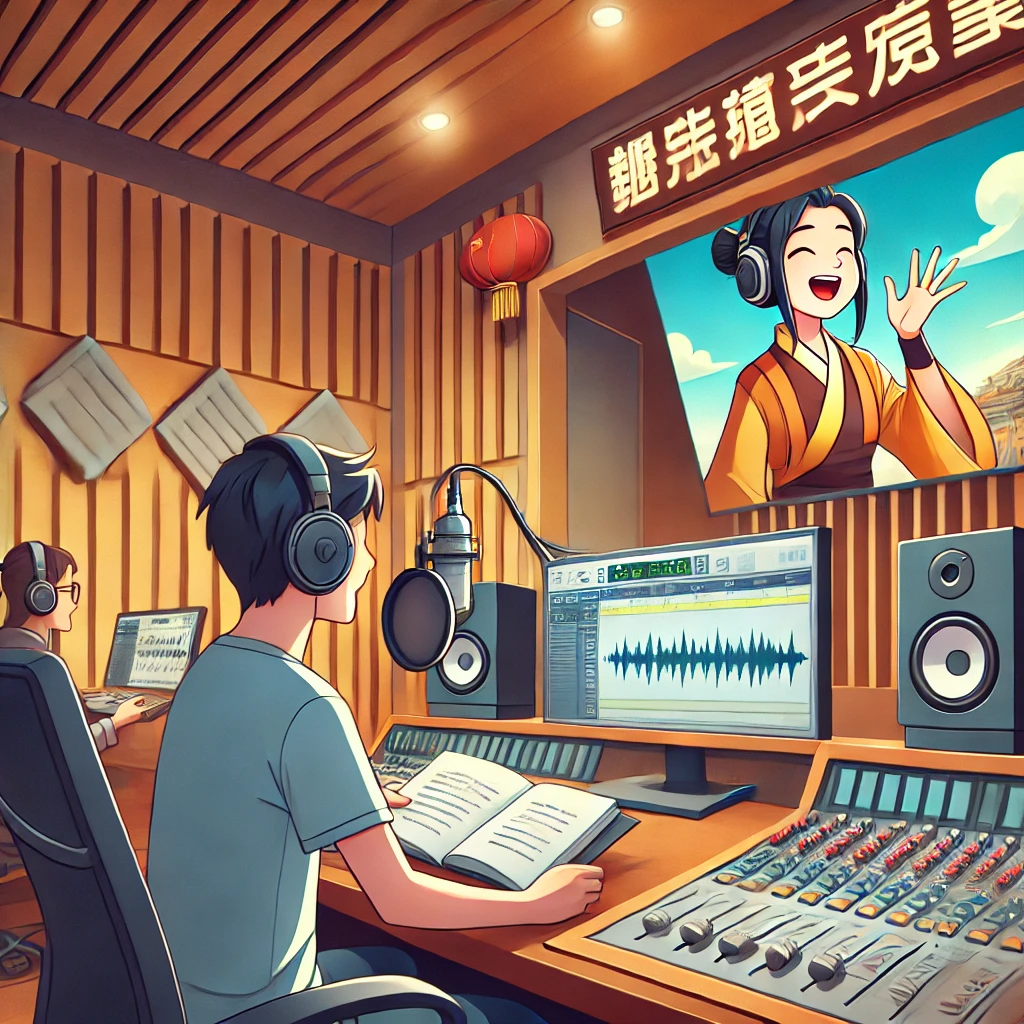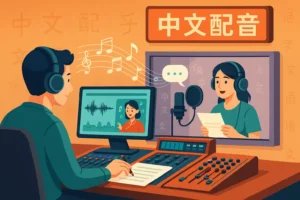Thinking about dubbing your animation into Chinese? Here’s how to choose the right voice talent, studio, and workflow for success.
4 Key Steps to Perfect Chinese Video Translation and Voice-Over
English to Chinese Video Translation Workflow: A Complete Guide for Global Brands
What is Chinese Dubbing?

Chinese dubbing is the process of replacing the original language of a video with a professionally recorded Chinese voice track, ensuring perfect lip-sync and emotional accuracy. Unlike basic voice-over narration, dubbing replicates the expressions, tone, and personality of characters, making the content more engaging and immersive.
Why Are Chinese Shows Always Dubbed?
Many Chinese TV shows and movies are dubbed due to:
- Dialects & Accents – China has hundreds of dialects, making it necessary to dub content into Standard Mandarin for broader accessibility.
- Post-Production Quality – Dubbing ensures consistent sound quality and removes on-set audio imperfections.
- Censorship & Content Control – Government regulations often require re-recording dialogue to ensure compliance with guidelines.
Dubbing isn’t just about language—it’s about enhancing storytelling and making content widely accessible.
How Can Chinese Dubbing Help Your Business?
Video content is king in China, and professional dubbing can:
- Increase engagement – Videos with localized voices feel more authentic.
- Boost brand awareness – Adapt marketing content to sound native.
- Improve learning retention – Make e-learning courses more effective.
- Enhance gaming experiences – Localized voiceovers bring characters to life.
With platforms like iQIYI, Youku, and Bilibili dominating China’s streaming market, dubbing is essential for reaching millions of viewers.
📊 Did You Know?
The global film dubbing market was valued at approximately USD 3.77 billion in 2023 and is projected to reach USD 7.05 billion by 2032, growing at a CAGR of 7.19% during the forecast period.
Chinese Dubbing vs. Chinese Voice-Over: What’s the Difference?

Many confuse dubbing with voice-over, but they serve different purposes:
🎙️ Voice-Over
✔ Narration-style, used for documentaries, audiobooks, and training videos.
✔ The original audio remains in the background while the new voice is overlaid.
🎭 Dubbing
✔ Replaces the original dialogue completely with a new voice track.
✔ Requires lip-syncing, emotional accuracy, and script adaptation.
✔ Used for movies, TV shows, animated content, and games.
📌 Key Takeaway: If your content involves characters and emotions, dubbing is the best choice.
What Are the Tools Used in Chinese Dubbing Services?
Many confuse dubbing with voice-over, but they serve different purposes:
🎙️ Voice-Over
✔ Narration-style, used for documentaries, audiobooks, and training videos.
✔ The original audio remains in the background while the new voice is overlaid.
🎭 Dubbing
✔ Replaces the original dialogue completely with a new voice track.
✔ Requires lip-syncing, emotional accuracy, and script adaptation.
✔ Used for movies, TV shows, animated content, and games.
📌 Key Takeaway: If your content involves characters and emotions, dubbing is the best choice.
What Are the Tools Used in Chinese Dubbing Services?
Professional dubbing requires advanced software to ensure seamless synchronization and high-quality production.
🎤 Recording & Synchronization Tools:
- VoiceQ – Automated dialogue replacement software for accurate timing.
- VocAlign PRO – Aligns new recordings with original dialogue.
- Adobe Audition / Audacity – Speech alignment and audio enhancements.
🎬 Post-Production Tools:
- WavePad – Adjusts pitch and speed for natural sound.
- Lip-sync AI tools – Ensures perfect character mouth movements.
Challenges in Chinese Dubbing and How to Overcome Them
Even experienced studios face hurdles:
- Cultural nuances – Humor, idioms, or metaphors may not translate directly. Solution: Use script adapters who are native Chinese speakers.
- Voice casting – Finding a voice that matches both the age and personality of a character is crucial. Solution: Request multiple demos before choosing.
- Time pressure – Rushed projects risk poor lip-sync. Solution: Build in review cycles during production.
These challenges highlight why choosing the right provider is essential.
How to Choose the Best Chinese Dubbing Service Provider?
Not all dubbing services deliver high-quality results. Before hiring a team, ask:
- Do they specialize in dubbing? – Request samples to assess quality.
- What’s their workflow? – Ensure a structured process from translation to final production.
- Who are their voice actors? – Experienced native Chinese speakers ensure authenticity.
- Are they responsive? – Quick communication prevents project delays.
- What software do they use? – Professional tools guarantee accurate lip-sync and high production quality.
💡 Insider’s Tip: Don’t settle for cheap dubbing services—poor quality can harm your brand’s reputation.
Ready to Bring Your Videos to Life?
If you’re serious about publishing professional animated videos, films, or e-learning content in China, Chinese dubbing is your best tool for engagement. With the rise of AI-assisted lip-syncing and the growing demand for localized streaming content, the role of dubbing will only become more important. Start planning your dubbing strategy today to make sure your content connects with Chinese audiences. Contact us now to create a dubbing solution that makes your projects shine in China.
